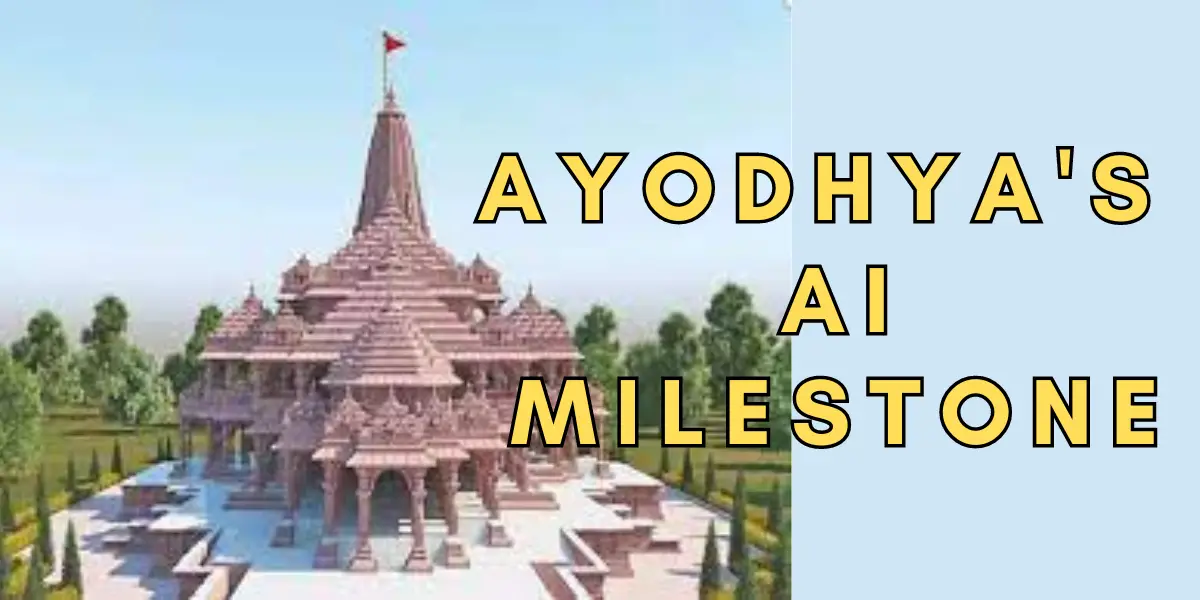Ayodhya's AI Milestone: High-Tech Ram Mandir Inauguration

As the Ram Mandir in Ayodhya opens its doors for a historic inauguration, a unique blend of tradition and cutting-edge technology unfolds. This event is not only a testament to India’s rich cultural heritage but also a showcase of how Artificial Intelligence (AI) and Machine Learning (ML) tools can revolutionize large-scale event management. From ensuring robust security with AI-enhanced surveillance systems to optimizing telecom services using AI-driven network management, this article delves into the various facets of AI and ML applications in the Ram Mandir inauguration. It highlights their impact on public safety, telecom services, cultural preservation, and the overall experience of this monumental event.
The Ram Mandir inauguration in Ayodhya exemplifies the successful integration of AI tools and ML in enhancing public safety, managing crowds, and improving connectivity.
Table of Contents
What is Ram Mandir Inauguration?
The Ram Mandir inauguration refers to the opening ceremony of the Ram Temple, a significant and much-anticipated event in Ayodhya, India. This event marks the completion and consecration of the Ram Temple, a structure of immense religious and cultural importance, particularly to the Hindu community. The temple is built on a site that is traditionally believed to be the birthplace of Lord Ram, a major deity in Hinduism. The inauguration is not just a religious ceremony but also a moment of national and cultural significance, symbolizing a fulfillment of long-standing aspirations and devotion.
The inauguration ceremony, scheduled for January 22, is expected to attract thousands of devotees, dignitaries, and visitors from across the country and the world. It is a historic event that combines traditional rituals with modern celebrations. Given the scale and importance of the event, extensive preparations and security measures are being undertaken. The use of advanced technologies like Artificial Intelligence (AI) and Machine Learning (ML) for crowd management, security, and ensuring seamless connectivity highlights the unique blend of tradition and technology at this grand event.
Also read:How To Create AI Ram Mandir T-Shirt Name With Bing AI?Quick Guide in Five Steps!,AI Transformation of Ram Mandir Inauguration: A High-Tech Marvel
AI-Powered Surveillance: Ensuring Unprecedented Security
Advanced Facial Recognition for Threat Identification
At the forefront of ensuring unprecedented security at the Ram Mandir inauguration is AI-powered facial recognition technology. This sophisticated system is capable of scanning crowds in real-time, identifying potential threats by cross-referencing faces against a database of known criminals or suspects. The technology’s precision in distinguishing individuals in large crowds is pivotal in preempting any security breaches. It operates continuously, providing security personnel with instant alerts on spotting any person of interest. This proactive approach to security is a game-changer, significantly reducing the reliance on manual monitoring and enhancing the overall safety of the event.
AI-Enhanced Drone Surveillance for Aerial Monitoring
The use of AI-enhanced drones represents a significant advancement in aerial surveillance, offering a bird’s-eye view of the entire event area. These drones are equipped with high-resolution cameras and AI algorithms that analyze video feeds in real-time. They are particularly effective in monitoring hard-to-reach areas and large crowds, providing comprehensive coverage that ground-based surveillance might miss. The drones can swiftly navigate to specific locations upon detecting unusual activities, enabling a rapid response to potential security threats. This level of surveillance not only ensures a higher security standard but also acts as a deterrent to potential wrongdoers.
Integrating AI with Traditional Security Measures
While AI-powered surveillance brings cutting-edge technology to the forefront, its integration with traditional security measures is crucial for a holistic security approach. AI systems work in tandem with on-ground security personnel, offering them insights and real-time data to make informed decisions. This synergy enhances the effectiveness of traditional security protocols, such as patrolling, bag checks, and manual surveillance. AI’s role in analyzing crowd behavior patterns also aids in deploying security personnel more strategically during the event. This integrated approach ensures that AI technology complements rather than replaces the human aspect of security, creating a robust and comprehensive security framework.

Innovative Telecom Solutions Powered by AI for the Grand Event
AI-Driven Network Optimization for High Traffic Management
The Ram Mandir inauguration posed a significant challenge in terms of telecom traffic management, which was adeptly handled by AI-driven network optimization. AI algorithms were employed to analyze network traffic patterns in real-time, dynamically adjusting bandwidth allocation to ensure seamless connectivity. This was crucial in accommodating the sudden surges in mobile data usage, typical of such large gatherings. The AI systems predicted high-traffic periods and redistributed network resources to prevent overload, thereby maintaining high-quality communication services throughout the event. This approach not only enhanced the attendee experience but also ensured that emergency services remained uninterrupted.
Real-Time Data Analytics for Enhanced Connectivity
AI played a pivotal role in enhancing connectivity through real-time data analytics. By continuously monitoring network performance, AI systems identified potential issues like signal drops or connectivity gaps. This enabled telecom providers to proactively address these issues, often before they impacted users. AI also facilitated the deployment of mobile towers and temporary Wi-Fi hotspots in areas predicted to experience high demand. This foresight ensured optimal coverage and bandwidth availability, making it easier for attendees to share their experiences in real time and stay connected with the outside world.
Personalized User Experience with AI-Enabled Applications
AI technologies were used to provide personalized experiences to attendees through AI-enabled applications. These apps offered real-time information on event schedules, navigation guides, and even crowd density in different areas of the venue. By analyzing individual user data and preferences, the apps provided customized notifications and recommendations, enhancing the overall user experience. This level of personalization, powered by AI, represented a significant advancement in how technology can be used to enrich attendee engagement in large-scale events.
AI in Action: Crowd Control and Incident Prevention
Predictive Analytics for Effective Crowd Management
AI’s role in crowd control at the Ram Mandir inauguration was crucial, with predictive analytics playing a key role. By analyzing patterns from various data sources, including past events, social media, and real-time surveillance feeds, AI systems anticipated crowd movements and densities. This information allowed event organizers to make preemptive adjustments to crowd management plans, such as opening or closing gates and redirecting foot traffic, to avoid overcrowding and ensure a smooth flow of attendees. Predictive analytics thus played a vital role in preempting potential crowd-related issues before they escalated.
AI-Enabled Surveillance for Incident Detection and Response
AI-enabled surveillance systems were instrumental in incident detection and response. These systems analyzed video feeds to detect anomalies like unattended bags, sudden gatherings, or altercations. Upon detecting a potential incident, the system alerted security personnel, who could quickly respond to the situation. This rapid detection and response capability was essential in maintaining a safe and secure environment for all attendees. The use of AI in surveillance not only enhanced security but also provided a sense of safety to the attendees, contributing to a more enjoyable event experience.
Collaborative AI Systems for Emergency Services Coordination
Collaborative AI systems played a vital role in coordinating emergency services during the event. By integrating data from various sources, including crowd surveillance, weather forecasts, and emergency service feeds, AI provided a comprehensive overview of the event’s security status. This integration enabled quick and efficient coordination among different emergency services, such as medical teams, fire services, and law enforcement. In the event of an emergency, AI systems could quickly identify the nearest response teams and guide them to the location, significantly reducing response times and enhancing the effectiveness of emergency management.

Balancing Tradition with Modern Technology: AI's Role in Cultural Preservation
AI as a Medium for Cultural Storytelling and Education
AI technology at the Ram Mandir inauguration played a significant role in cultural storytelling and education. Interactive AI-powered displays and virtual reality experiences were set up around the venue, offering attendees immersive stories about the temple’s history, Lord Ram’s life, and the significance of Ayodhya in Hindu mythology. These digital narrations, enhanced by AI’s ability to personalize content based on viewer interest, provided a modern medium for preserving and passing on cultural stories and traditions. This innovative use of AI not only engaged a younger, tech-savvy generation but also ensured that the rich tapestry of India’s cultural heritage was conveyed in a contemporary and accessible manner.
Preserving Architectural Heritage through AI-Enabled Monitoring
AI’s role in preserving the architectural heritage of the Ram Mandir was pivotal. Advanced AI algorithms were used to monitor the structural integrity of the temple, analyzing data from sensors placed throughout the site. This real-time monitoring allowed for the early detection of potential structural issues, ensuring timely maintenance and preservation. Additionally, AI-powered 3D modeling and digital archiving created detailed records of the temple’s architecture, providing valuable resources for future restoration and research. This blend of traditional architecture with modern AI technology not only safeguarded the physical structure but also ensured that its historical and cultural significance was preserved for future generations.
Ethical Considerations and Privacy in AI Implementation
Navigating the Privacy Implications of AI Surveillance
The implementation of AI-powered surveillance systems, while enhancing security, raised important privacy concerns. Ensuring that the use of facial recognition and other surveillance technologies complied with ethical standards was crucial. Measures were taken to limit the scope of surveillance to public areas, avoiding intrusion into private spaces. Data collected through AI systems was handled with strict privacy protocols, ensuring that personal information was protected and used only for security purposes. Transparency in the use of AI surveillance, along with clear communication about its scope and purpose, helped in addressing privacy concerns and maintaining public trust.
Ethical Use of AI in Crowd Management
In managing the vast crowds at the Ram Mandir inauguration, the ethical use of AI was a key consideration. AI systems were designed to respect individual rights and avoid any form of discrimination. Algorithms used for crowd analysis and management were scrutinized for biases, ensuring that all decisions made by AI were fair and unbiased. The focus was on using AI as a tool for ensuring safety and convenience for all attendees, regardless of their background. By prioritizing ethical considerations in the deployment of AI for crowd management, the event set a standard for how technology can be used responsibly in managing public gatherings.
Conclusion
The Ram Mandir inauguration in Ayodhya is not just a landmark event in terms of cultural and religious significance; it also marks a revolutionary step in the integration of AI and ML technologies in managing large-scale public events. From enhancing security with AI-powered surveillance to revolutionizing crowd management and improving telecom services, AI has played a pivotal role in ensuring the event’s success. This fusion of tradition with modern technology not only sets a new standard for public safety and event management but also opens up avenues for AI in cultural preservation and education. The successful implementation of AI at the Ram Mandir inauguration serves as a blueprint for future events, showcasing the immense potential of AI and ML in harmonizing tradition with technological advancement.

